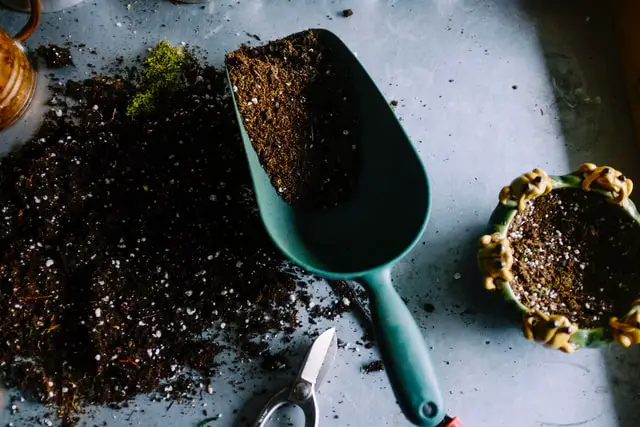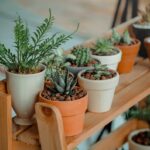There are plants that like moisture and thrive best in soil that maintains a constant level of moisture for them. Simply increasing the frequency with which you water your plants seems like it would be an easy thing to accomplish. This is a solution that is fantastic for the short term but is not really effective for the long run at all.
What would happen to your plant if you are on vacation for two weeks and are unable to water it? How do you maintain a wet soil without luring in unwanted bugs or drowning your plant by giving it too much water?
In this article, we are going to discuss ways in which the soil may be improved so that it can more effectively retain water. In the following paragraphs, we will also discuss why merely watering your plant more frequently is not an effective long-term strategy. There are a lot of other, much more effective and environmentally friendly methods to keep your plant happy and help it flourish.
The following are some of the topics that will be discussed:
- Why additional watering isn’t a long-term answer
- The ideal soil for plants that require a lot of moisture.
- Good drainage for moisture-loving plants
Let’s look at why watering more frequently isn’t a long-term answer for your moisture-loving plants.
Read more: 5 Beginner-Friendly Low Light Houseplants
Table of Contents
Why additional watering isn’t a long-term answer
The best long-term strategy is not to water your plant more frequently in an effort to provide it with additional moisture. Why not, though? I’ll give you three reasons why:
- Your plant looks to you for support.
- Over time, the soil becomes more compact.
- unintentional overwatering
1. Your plants look to you for support.
In order to acquire adequate water for your plant, it needs you to be present more frequently. If you can’t water your plant for more than a week at a time for whatever reason, it will dry out and die. You cannot take a trip without being preoccupied with the possibility that your houseplants could perish while you are away.
That is something that every owner of a plant has worried about at some time in their lives, but thankfully, things don’t have to be that way any more.
Read more: Why Should You Not Be Afraid Of Pruning Your Houseplants
2. Over time, the soil becomes more compact.
Soil compaction is a further reason why watering your plant more frequently is not a smart strategy to maintain its health. When you consistently water your plant, the soil will eventually get compacted and thick.
The roots of most houseplants suffer when they are grown in dense soil because this type of soil does not provide as much oxygen to reach the plant’s roots. Root rot can occur if the roots of your plant are deprived of oxygen for an extended period of time.
Additionally, dense soil is not particularly good at draining away the surplus water that has accumulated. This environment is ideal for the spread of fungus.
Read more: How to Use a Moss Pole for Houseplants?
3. unintentional overwatering
It is possible that you will overwater your plants if you increase the frequency with which you water them. It takes a few days for plants to react when there is a problem with the amount of water they receive. You run the danger of killing your plant by overwatering it if you misunderstand the watering instructions on your plant and give it more water than you should have.
You will drastically reduce the likelihood of making mistakes if you are able to lengthen the intervals in which you water the plants. You may observe how your plant reacts over the course of a few days to determine whether or not you need to make any adjustments to the way you care for your plant.
Read more: How to get your houseplants ready for spring?
How can you create the ideal soil for water-loving plants?
Frequently watering your plants does not work in the long run; what does work? There are a number of effective approaches that can be taken to assist your soil in retaining more moisture, all while maintaining the health of your plant.
To begin, we will have to investigate the qualities and characteristics of ideal soil for plants that thrive in damp environments. The ideal soil for your plants that thrive in damp environments should have:
- Keep the soil wet for several days.
- Maintain its structure to keep the soil from compacting.
- Allow the extra water to drain rapidly.
This soil will maintain the proper moisture level for your plants without being overwatered. This soil will also ensure that enough of oxygen reaches the roots of your plants. Speaking is easy, therefore let’s put our words into action.
Read more: How can you get rid of spider mites on your houseplants?
What you need is
In the following paragraphs, we are going to discuss the many components that must be included in your soil. If you add these components to your soil, it will be able to retain water for a longer period of time, without putting your plant’s wellbeing in jeopardy.
To retain extra moisture, you’ll need any of the following ingredients:
- Vermiculite
- Sphagnum moss (peat)
- Coconut coir
You don’t need to use all three. It is sufficient for your soil to use either one or two of these ingredients.
You’ll also need to include drainage-improving substances; any of the following will do:
- Perlite
- Leca
- Grainy sand
Now let’s examine what each of these items are and how they might assist you in maintaining more soil moisture. After that, you’ll have the option of choosing which one you wish to use going forward.
Read more: How do you take care of houseplants in the winter?
What exactly is Vermiculite and how can it be used?
Vermiculite is a mineral that is found in nature and is heated until it expands and forms small, light particles. It is a type of material that, by its very nature, is resistant to mold and other infectious illnesses and has a high capacity for holding water. It will never spoil, is completely non-toxic, and is sterile.
Because of this, it is an excellent choice for long-term use with the plants in your garden that adore having their soil kept moist.
You may incorporate it into your soil in the same way that you would perlite. It is available at practically all garden centers for a reasonable price. Because vermiculite is not a natural growth medium for plants, it does not contain any nutrients that will help your plants thrive. You’ll need to supplement these nutrients with soil and fertilizer.
Because vermiculite may hold onto a significant amount of water, you need to be careful not to add too much of it when you are combining it with soil. A suitable ratio is 1 /6 vermiculite, 2 /6 leca, perlite, or sand, and 3 /6 soil.
Advantages: sterile, mold-resistant, and does not spoil.
Sphagnum moss (peat)
Both Sphagnum moss and Peat moss are the same sort of moss: they are both dead and dry. The only distinction that can be made between the two is in the manner in which they are gathered. Sphagnum moss is gathered as living plants and subsequently dried, whereas peat moss is obtained as dead moss from the ground.
Peat moss is a great way to keep additional moisture in the soil, and you may use it if you have a plant that does well in soil that is more acidic. However, if your plant requires more neutral soil, Sphagnum moss provides the necessary water retention qualities.
You may make use of either of these kinds of moss by incorporating it into the soil in some way. The soil will benefit from the pieces of moss’s ability to easily retain moisture while also gaining some structure from them. This helps to keep the soil from compacting.
Since moss is a natural product, it does include certain nutrients that can assist in the growth of your plants. The majority of the nutrients, however, will be supplied by the soil and any fertilizer that is applied.
If you wish to incorporate Sphagnum moss into your soil, you should add approximately one third of the moss, one third of the soil, and one third of the leca, perlite, or sand.
Read more: How to prevent overwatering plants?
Benefits include antibacterial and antifungal activities, as well as pH neutrality.
Coconut coir
The term “waste product” accurately describes the substance known as coconut coir. If you want to boost water retention in your soil, coconut coir is an excellent addition. If you apply this to your soil, the structure of your soil will be improved as a result of the addition of the fibers. The strands hold each other in place fairly nicely, preventing your soil from compacting.
Aside from these highly practical benefits, coconut coir also protects your soil and plants from diseases. It’s a safe solution that enhances water retention while avoiding mold growth.
Coconut coir, much like vermiculite, does not contain any nutrients that are useful to your plants on its own. This implies you’ll have to mix it with something that does, such as soil.
If you want to utilize coconut coir to increase your soil’s water retention, you’ll need to add perlite, sand, or Leca to promote drainage. The coir does not drain properly and may pose complications if not adequately drained.
A good rule of thumb is to use one third soil, one third coconut coir, and one third perlite, leca, or sand.
Benefits: it protects against diseases and has the right pH level for nutrients to be absorbed.
Good drainage for moisture-loving plants
Sand, perlite, and leca are some of the components that you may add to your soil to help enhance drainage. It may sound odd to include this component in soil in order to increase its capacity to hold water, but there is a rationale behind the decision to do so.
When you add materials to your soil such as vermiculite, sphagnum moss, and/or coconut coir, you are adding components that are able to retain a significant amount of water. This soil will tend to compress itself in an effort to hold on to as much moisture as it can. Because of this, the surplus water will be retained in the soil, which is not good for drainage.
Because of this, you will need to aerate the soil so that it can form pockets that are both draining and holding water. This may be accomplished by including some Leca, Perlite, or Sand in the soil combination that you are using.
The Leca, the Perlite, and the sand all work together to ensure that any extra water drains swiftly to the bottom of the pot. Both Leca and Perlite work to maintain the structure of your soil, which helps to prevent the soil from becoming compacted.
This is possible due to the fact that Leca and Perlite are relatively huge in comparison to sand. By aerating your soil, you may stop yourself from overwatering your plants and open up channels for oxygen to reach their roots.
Sand, Perlite, or Leca are all viable options; nevertheless, you are free to choose the one that best suits your needs.
Check out “How to Make Your Soil Drain Quickly?” if you’d want to learn more about enhancing the drainage of your soil, including additional methods not listed here.
Read more: How do I buy houseplants in the winter?
Conclusion
When you provide your moisture-loving plants with the moisture they require, they will be content for a long time. There are a few long-term options for keeping your plants happy. These long-term treatments not only make you feel more at peace, but they also promote the growth of your plants.
The addition of vermiculite, sphagnum (peat) moss, and/or coconut coir to your soil can enhance its ability to retain water, which is beneficial for growing plants. In order to prevent any problems with watering that could arise, you will need to increase the drainage once you have made the soil more capable of holding onto water. You may enhance the drainage of your soil by including perlite, Leca, and sand into the mix.
A mixture of these factors will ensure that your plants are constantly in the soil they prefer: damp but not soggy; plenty of oxygen to keep pests at bay; and lots of nutrients to flourish in.
I appreciate you taking the time to read my article. I really hope that this information is of use to you in maintaining the health and beauty of your plants.
Frequently Asked Questions
How do you make soil retain more water?
Vermiculite, sphagnum (peat) moss, and coconut coir are some of the components that may be added to your soil in order to increase its ability to retain water.
What is vermiculite?
The naturally occurring mineral vermiculite is subjected to high temperatures in order to cause it to expand and crystallize into vermiculite particles. It is a type of material that, by its very nature, is resistant to mold and other infectious illnesses and has a high capacity for holding water.
How can you use Sphagnum moss with houseplants?
Since sphagnum moss is able to hold onto a significant amount of water, it may be combined with soil to make the latter more resistant to drying out. Your plants that require a lot of moisture will benefit from this.
Photo by Neslihan Gunaydin on Unsplash


